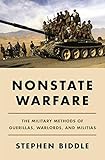Nonstate Warfare : The Military Methods of Guerillas, Warlords, and Militias / Stephen Biddle.
Material type: TextPublisher: Princeton, NJ : Princeton University Press, [2021]Copyright date: ©2021Description: 1 online resource (464 p.) : 16 b&w illus. 6 tables. 7 mapsContent type:
TextPublisher: Princeton, NJ : Princeton University Press, [2021]Copyright date: ©2021Description: 1 online resource (464 p.) : 16 b&w illus. 6 tables. 7 mapsContent type: - 9780691216652
- Asymmetric warfare -- Case studies
- Guerrilla warfare -- Case studies
- Militia -- Case studies
- Non-state actors (International relations) -- Case studies
- POLITICAL SCIENCE / Security (National & International)
- Admiral Jonathan Howe
- Andrea Dew
- Croatian Wars of Independence
- Fabian
- HV
- Hezbollah
- Insurgents, Terrorists and Militias
- JAM
- Jaish al-Mahdi
- Militias
- Napoleonic
- SNA
- SVK
- Second Indochina War
- Seth Jones
- Somali National Alliance
- Stathis Kalyvas
- The Logic of Violence in Civil Warfare
- Waging Insurgent Warfare
- ZNG
- asymmetric
- collective action dilemmas
- guerillas
- internal political determinants
- intrastate
- material incentives
- material inferiority
- materialist theories
- midspectrum warfare
- specialist subunits
- tribal culture
- warfighting
- warlords
- 355.02/18 23
- U163 .B532 2021
- online - DeGruyter
| Item type | Current library | Call number | URL | Status | Notes | Barcode | |
|---|---|---|---|---|---|---|---|
 eBook
eBook
|
Biblioteca "Angelicum" Pont. Univ. S.Tommaso d'Aquino Nuvola online | online - DeGruyter (Browse shelf(Opens below)) | Online access | Not for loan (Accesso limitato) | Accesso per gli utenti autorizzati / Access for authorized users | (dgr)9780691216652 |
Browsing Biblioteca "Angelicum" Pont. Univ. S.Tommaso d'Aquino shelves, Shelving location: Nuvola online Close shelf browser (Hides shelf browser)

|

|

|

|

|

|

|
||
| online - DeGruyter In Humboldt's Shadow : A Tragic History of German Ethnology / | online - DeGruyter Subtle Tools : The Dismantling of American Democracy from the War on Terror to Donald Trump / | online - DeGruyter Power to the Public : The Promise of Public Interest Technology / | online - DeGruyter Nonstate Warfare : The Military Methods of Guerillas, Warlords, and Militias / | online - DeGruyter This Land Is Our Land : The Struggle for a New Commonwealth / | online - DeGruyter Deaths of Despair and the Future of Capitalism / | online - DeGruyter Not Working : Where Have All the Good Jobs Gone? / |
Frontmatter -- Contents -- Figures -- Tables -- Maps -- Preface -- 1 Introduction -- 2 The Fallacy of Guerilla Warfare -- 3 Materially Optimal Behavior -- 4 Politically Achievable Behavior -- 5 Hezbollah in the 2006 Lebanon Campaign -- 6 The Jaish al Mahdi in Iraq, 2003–8 -- 7 The Somali National Alliance in Somalia, 1992–94 -- 8 The ZNG, HV, and SVK in the Croatian Wars of Independence, 1991–95 -- 9 The Vietcong in the Second Indochina War, 1965–68 -- 10 Conclusion and Implications -- Appendix -- Notes -- Index
restricted access online access with authorization star
http://purl.org/coar/access_right/c_16ec
How nonstate military strategies overturn traditional perspectives on warfareSince September 11th, 2001, armed nonstate actors have received increased attention and discussion from scholars, policymakers, and the military. Underlying debates about nonstate warfare and how it should be countered is one crucial assumption: that state and nonstate actors fight very differently. In Nonstate Warfare, Stephen Biddle upturns this distinction, arguing that there is actually nothing intrinsic separating state or nonstate military behavior. Through an in-depth look at nonstate military conduct, Biddle shows that many nonstate armies now fight more "conventionally" than many state armies, and that the internal politics of nonstate actors—their institutional maturity and wartime stakes rather than their material weapons or equipment—determines tactics and strategies.Biddle frames nonstate and state methods along a continuum, spanning Fabian-style irregular warfare to Napoleonic-style warfare involving massed armies, and he presents a systematic theory to explain any given nonstate actor’s position on this spectrum. Showing that most warfare for at least a century has kept to the blended middle of the spectrum, Biddle argues that material and tribal culture explanations for nonstate warfare methods do not adequately explain observed patterns of warmaking. Investigating a range of historical examples from Lebanon and Iraq to Somalia, Croatia, and the Vietcong, Biddle demonstrates that viewing state and nonstate warfighting as mutually exclusive can lead to errors in policy and scholarship.A comprehensive account of combat methods and military rationale, Nonstate Warfare offers a new understanding for wartime military behavior.
Mode of access: Internet via World Wide Web.
In English.
Description based on online resource; title from PDF title page (publisher's Web site, viewed 01. Dez 2022)


